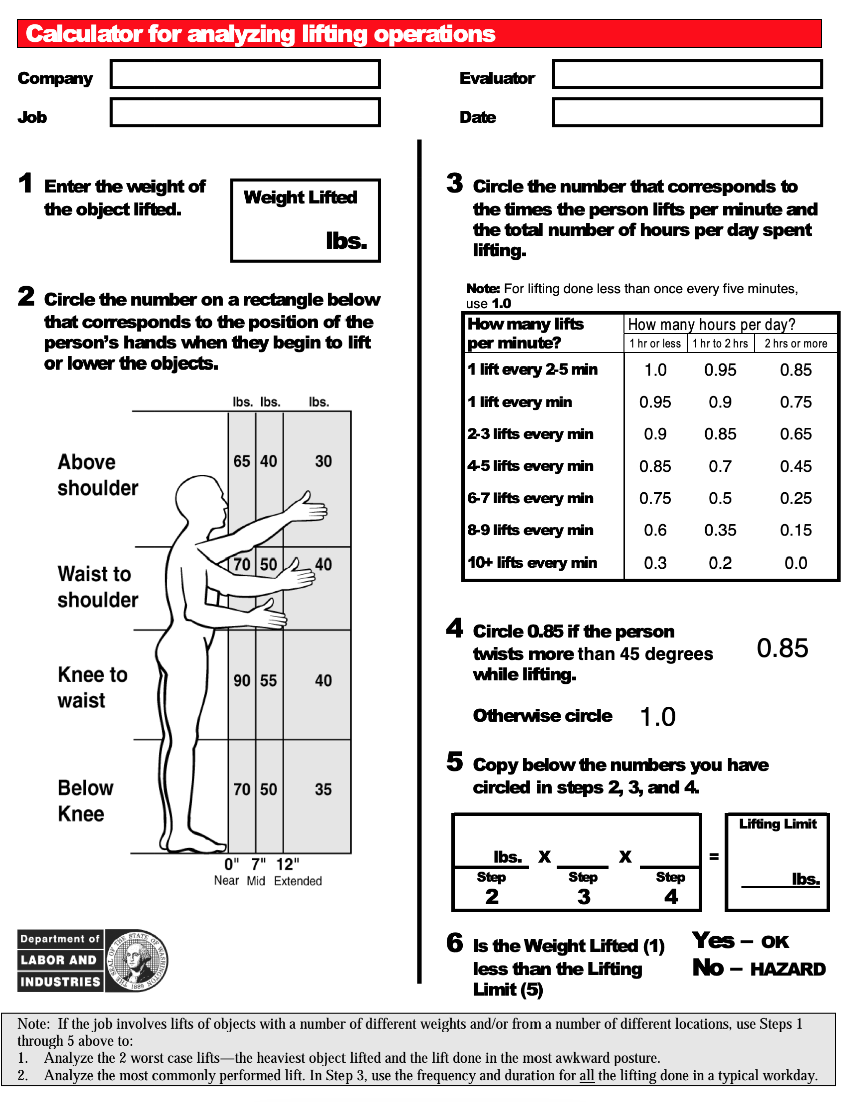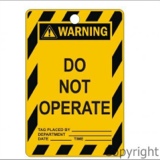Title Page
-
Site where assessment was conducted:
-
Conducted on
-
Prepared by
-
Location (GPS)
-
Location (Text)
Assessment
Employee Details
-
Employee Name and Surname
-
ID Number
-
ID Photograph
-
Position / Job title
- Cleaner
- Administrative worker
- Storeman
- MEWP Operator
- Telehandler Operator
- Crane Operator
- Spray Painter
- Welder
- Driver
-
Length of time on the assessed job? Years
-
Job Tasks
-
Sex
-
Height (m)
Checklist
-
Reading across the page, determine if any of the conditions are present in the work activities. For many of the risk factors, two conditions are presented, which are the indicators for Caution and Hazard. Most of the conditions are based on duration. If the lower threshold condition is not met, the "no" box is checked. If the lower condition is met but the higher is not, then Caution is checked. If the higher condition is met (generally a longer period of time), then Hazard is checked. If only Caution boxes are checked, some risk is present. It is worthwhile to continue to monitor Caution level jobs for changes that might increase the risk and for the occurrence of injuries or symptoms. If one or more Hazard boxes are checked, a work-related musculoskeletal disorder (WMSD) hazard exists, and immediate action (further analysis or intervention) is recommended. The checklist is divided into four body zones • Low Back • Hand and Wrist • Neck and Shoulder • Knee Note: Washington State Department of Labor and Industries published two checklists (Caution Zone and Hazard Zone). This checklist is an attempt by a third party to combine the lists. See www.lni.wa.gov/Safety/Topics/Ergonomics/ServicesResources/Tools/ WISHA is the Washington Industrial Safety and Health Act.
1.Awkward Posture
-
1.1 Working with the hand(s) above the head, or the elbow(s) above the shoulders more than 2 hours total per day.
-
1.1.2 Working with the hand(s) above the head, or the elbow(s) above the shoulders more than 4 hours total per day.
-
1.1.3 Repeatedly raising the hand(s) above the head, or the elbow(s) above the shoulder(s) more than once per minute more than 4 hours total per day.
-
1.1.4 Working with the neck bent more than 45° (without support or the ability to vary posture) more than 4 hours total per day.
-
1.2 Working with the back bent forward more than 30° (without support or the ability to vary posture) more than 4 hours total per day.
-
1.2.1 Working with the neck or back bent more than 30 degrees (without support and without the ability to vary posture) more than 4 hours total per day.
-
1.3 Working with the back bent forward more than 45° (without support or the ability to vary posture) more than 2 hours total per day.
-
1.3.1 Working with the back bent forward more than 45° (without support or the ability to vary posture) more than 4 hours total per day.
-
1.4 Squatting for more than 2 hours total per day
-
1.4.1 Squatting for more than 4 hours total per day
-
1..5 Kneeling for more than 2 hours total per day
-
1.5.1 Kneeling for more than 4 hours total per day
2.High Hand Force
-
2.1 Pinching an unsupported object(s) weighing 0.9 kg or more per hand, or pinching with a force of 1.8 kg or more per hand, more than 2 hours total per day (comparable to pinching half a ream of paper).
-
2.1.1 with highly repetitive motion AND more than 3 hours per day
-
2.1.2v with lateral and horizontal bending of wrist AND more than 3 hours total per day
-
2.1.3 With no additional risk factors AND more than 4 hours per day
-
2.2 Gripping an unsupported objects(s) weighing 4.5 kg or more per hand, or gripping with a force of 4.5 kg or more per hand, more than 2 hours total per day (comparable to clamping light duty automotive jumper cables onto a battery).
-
2.2.1 with highly repetitive motion AND more than 3 hours per day
-
2.2.2 with lateral and horizontal bending of wrist AND more than 3 hours total per day
-
2.2.3 With no additional risk factors AND more than 4 hours per day
3.Highly repetitive Motion - Neck, shoulders, elbows, Wrists, hands
-
3.1 Using the same motion with little or no variation every few seconds (excluding keying activities) combined with Wrists bent in flexion 30° or more, or in extension 45° or more, or in ulnar deviation 30° or more AND High, forceful exertions with the hand(s) fort more that 2 hours per day
-
3.1.1 with forceful exertions with the hand (s) AND more than 3 hours total per day
-
3.1.2 with no other risk factors AND more than 3 hours per day
-
3.2 Intensive keying with no other risk factors for more than 4 hours per day
-
3.2.1 with lateral and horizontal bending of wrist AND more than 4 hours total per day
-
3.2.2 with no other risk factors AND more than 7 hours per day
4.Repeated Impact
-
4.1 Using the hand (heel/base of palm) or knee as a hammer more than 10 times per hour, more than 2 hours total per day.
-
4.1.1 Using the hand (heel/base of palm) as a hammer more than once per minute
-
4.1.2 Using the knee as a hammer as a hammer more than once per minute
5.Heavy, Frequent or Awkward Lifting (A simple scale can be used to determine the weight of materials)
-
5.1 Lifting object weighing more than 30kg once per day or more than 25 kg more than 10 times per day.
-
5.2 Lifting objects weighing more than 5 kg if done more than twice per minute, more than 2 hours total per day.
-
5.3 Lifting objects weighing more than 10kg above the shoulders, below the knees or at arms length more than 25 times per day.
WISHA Lifting Calculator
-
Note: If the job involves lifts of objects with a number of different weights and/or from a number of different locations, use Steps 1
through 5 above to:
1. Analyze the 2 worst case lifts—the heaviest object lifted and the lift done in the most awkward posture.
2. Analyze the most commonly performed lift. In Step 3, use the frequency and duration for all the lifting done in a typical workday. -
STEP 1 Enter the weight of the object lifted. kg
-
STEP 2 Select the number on a rectangle in the diagram that corresponds to the position of the person’s hands when they begin to lift or lower the objects. - select number
- Above shoulder 30 lbs./ 13.6 kg
- Above shoulder 40 lbs./ 18.1 kg
- Above shoulder 60 lbs./ 27.2 kg
- Waist to shoulder 40 lbs./ 18.1 kg
- Waist to shoulder 50 lbs./ 22.6 kg
- Waist to shoulder 70 lbs./ 31.7 kg
- Knee to waist 40 lbs./ 18.1 kg
- Knee to waist 40 lbs./ 18.1 kg
- Knee to waist 40 lbs./ 18.1 kg
- Below Knee 35 lbs./ 15.8 kg
- Below Knee 50 lbs./ 22.6 kg
- Below Knee 70 lbs./ 31.7 kg
-
STEP 3 Select the number that corresponds to the times the person lifts per minute and the total number of hours per day spent lifting. Note: For lifting done less than once every five minutes, use 1.0
- 1 lift every 2-5 min 1 hr or less per day 1.0
- 1 lift every 2-5 min 1 hr - 2 hrs per day 0.95
- 1 lift every 2-5 min 2 hrs or more per day 0.85
- 1 lift every min 1 hr or less per day 0.95
- 1 lift every min 1 hr - 2 hrs per day 0.9
- 1 lift every min 1 hr - 2 hrs per day 0.75
- 2-3 lifts every min 1 hr or less per day 0.9
- 2-3 lifts every min 1 hr - 2 hrs per day 0.85
- 2-3 lifts every min 1 hr - 2 hrs per day 0.65
- 4-5 lifts every min 1 hr or less per day 0.85
- 4-5 lifts every min 1 hr - 2 hrs per day 0.7
- 4-5 lifts every min 2 hrs or more per day 0.45
- 6-7 lifts every min 1 hr or less per day 0.75
- 6-7 lifts every min 1 hr - 2 hrs per day 0.5
- 6-7 lifts every min per day 0.25
- 8-9 lifts every min 1 hr or less per day 0.6
- 8-9 lifts every min 1 hr - 2 hrs per day 0.35
- 8-9 lifts every min 1 hr - 2hrs per day 0.15
- 10+ lifts every min 1 hr or less per day 0.3
- 10+ lifts every min 1 hr - 2 hrs per day 0.2
- 10+ lifts every min 1 hr - 2 hrs per day 0.0
-
STEP 4 Does the person twist more than 45 degrees while lifting
-
STEP 5 Calculate using the numbers STEP 2 x STEP 3 x STEP 4 = Lifting limit
-
Is the weight of the object in STEP 1 less than the Lifting Limit calculated in STEP 5 ?
undefined
6.Moderate to High Hand - Arm Vibration (Closely estimate or obtain the vibration value of the tool in use)
-
6.1 Using impact wrenches, carpet strippers, chain saws, percussive tools (jackhammers, scalers, riveting or chipping hammers) or other tools that typically have high vibration levels, more than 30 minutes total per day.
-
Calculate vibration Index
-
6.2 Using grinders, sanders, jigsaws or other hand tools that typically have moderate vibration levels more than 2 hours total per day.
-
Calculate vibration index












